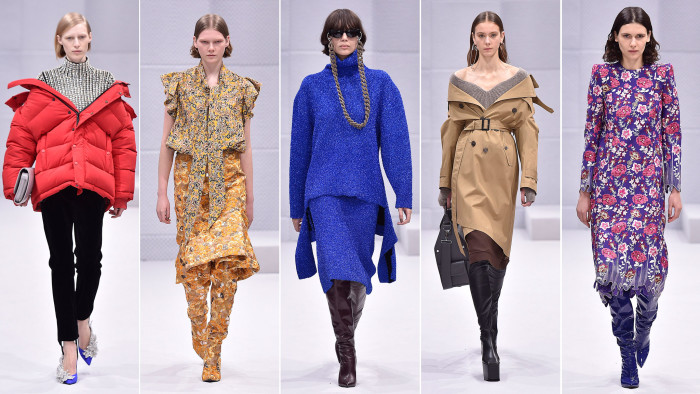Balenciaga AW16 show report Paris Fashion Week

Simply sign up to the Life & Arts myFT Digest -- delivered directly to your inbox.
Some shows are simply game-changing: you-had-to-be-there moments. On Sunday morning the Kering-owned house showed its first collection under the artistic direction of designer Demna Gvasalia, co-founder of the Vetements label and a fashion disrupter who is currently the most talked about name in Paris — even if no one quite knows how to pronounce his name.
Knowing the attention surrounding his debut would be forensic, Gvasalia had spent time in the archives deciding on which direction he would take with the house established by the celebrated Spanish couturier Cristóbal Balenciaga in 1937. Balenciaga’s own aesthetic was just as disruptive at the time, and his extreme silhouettes, “bubble skirts” and plays with proportion were considered radical and reactionary before being adopted by the fashion mainstream. For Gvasalia, as with Nicolas Ghesquière and (to a lesser extent) Alexander Wang who went before him, it is the legacy of Balenciaga to invite extreme ideas and brand new points of view.
For his first collection, Gvasalia was “toying with the notion of sophistication” and how to transform “a couture attitude into the modern utilitarian wardrobe”. Rather than work with the silhouette, he had worked with the manner in which one wears the clothes: like “vogueing” really, the collection was all about the shapes it threw.
“I drew on the Balenciaga elements in the architecture of the collection,” explained the Georgia-born designer backstage. “I drew on my own aesthetic and design instincts in the choices of garment, the approach and the attitude of the clothes.”
Many of the new Balenciaga pieces were quotidian; a trenchcoat, a plaid suit, a puffer jacket and a floral dress. But nothing about them looked normal. Most of the emphasis, as at the AW16 Vetements show last week, was in the shoulder. Gvasalia had reconstructed the shapes so that the coats and ski jackets were shrugged off at the back, while suit jackets were drawn up towards the chin or broadened, exaggerated and oversized. A sparkly silver top and skirt made for easy evening separates: easy mainly because they were so simple to wear.
The waists, too, were sculpted and concave, to arch the back or throw the hips forward. “These aren’t styling tricks,” explained Gvasalia. “That’s all part of the construction.”
Most importantly, seismic in fashion, was each piece’s “relatability”. A velvet embroidered evening gown with bandeau top was fluid through the waist and unrestrictive: it was wearable. These were clothes for real life. Normal, simple unpretentious pieces that will still give the modern woman’s wardrobe a wallop of intrigue: striped shirts, bulbous denim jackets, fantastic leathers and big stack-heeled shoes.
Much as he has done at Vetements, Gvasalia has created clothes that work. The show was staged in a soundproofed white space, with plain walls and under harsh light. “Unromantic,” said Gvasalia, as though to drive his utilitarian point home. I loved it.
Photographs: Catwalking
Comments